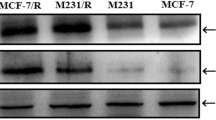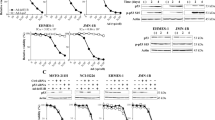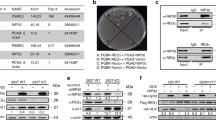Abstract
In this article, we investigated the effect induced by the reintroduction of wild-type p53 (wt-p53) protein on BCNU sensitivity in the ADF glioblastoma line. Using a wt-p53 recombinant adenovirus (Ad-p53), we demonstrated that exogenous wt-p53 expression was able to increase the sensitivity to BCNU in ADF cells. Interestingly, this effect was more evident when Ad-p53 infection was performed after BCNU treatment compared with the opposite sequence. To understand the biological basis of these different behaviors, we analyzed the cell cycle of the differently treated cells. We found that Ad-p53 infection induced a persistent accumulation of cells in the G0/G1 phase while, as expected, BCNU induced a block in the G2-M phase. Ad-p53→BCNU sequence did not significantly mod- ify the cell cycle profile in respect of Ad-p53 infected cells. In contrast, BCNU→Ad-p53 sequence provoked G2-M arrest similar to that observed after treatment with BCNU alone, but prevented the later recovery of the cells through the cell cycle, by driving the cells to apoptotic death. These results demonstrate that the administration sequence is important to increase drug sensitivity. To generalize the phenomenon observed on ADF line, the antiproliferative effect of the two different schedules was analyzed on other glioblastoma lines (A172, CRS-A2, U373MG) with different BCNU sensitivity and p53 status. The data obtained confirm that the wt-p53 gene transfer enhances BCNU sensitivity in glioblastoma cells depending on the administration sequence.
This is a preview of subscription content, access via your institution
Access options
Subscribe to this journal
Receive 12 print issues and online access
$259.00 per year
only $21.58 per issue
Buy this article
- Purchase on Springer Link
- Instant access to full article PDF
Prices may be subject to local taxes which are calculated during checkout








Similar content being viewed by others
References
Maxwell M et al. Coexpression of platelet-derived growth factor (PDGF) and PDGF-receptor genes by primary human astrocytomas may contribute to their development and maintenance J Clin Invest 1990 86: 131–140
Ammirati M, Galicch JH, Arbit E, Liao Y . Re-operation in the treatment of recurrent intracranial malignant gliomas Neurosurgery 1987 21: 607–614
Tannock IF . Experimental chemotherapy and concepts related to the cell cycle Int J Radiat Biol 1986 49: 335–355
Brandes AA, Fiorentino MV . The role of chemotherapy in recurrent malignant gliomas: an overview Cancer Invest 1996 14: 551–559
Ohgaki H et al. Mutations of the p53 tumor suppressor gene in neoplasms of the human nervous system Mol Carcinog 1993 8: 74–80
Frankel RH, Bayona W, Koslow M, Newcomb EW . P53 mutations in human malignant gliomas: comparison of loss of heterozygosity with mutation frequency Cancer Res 1992 52: 1427–1433
Hollstein M, Sidransky D, Vogelstein B, Harris CC . P53 mutations in human cancers Science 1991 253: 49–53
Levine AJ, Momand J, Finlay CA . The p53 tumour suppressor gene Nature 1991 351: 453–455
Fults D et al. P53 mutation and loss of heterozygosity on chromosomes 17 and 10 during human astrocytoma progression Cancer Res 1992 52: 674–679
Malkin D . P53 and the Li–Fraumeni syndrome Cancer Genet Cytogenet 1993 66: 83–92
Louis DN . The p53 gene and protein in human brain tumors J Neuropathol Exp Neurol 1994 53: 11–21
Hayashi Y, Yamashita J, Yamaguchi K . Timing and role of p53 gene mutation in the recurrence of glioma Biochem Biophys Res Comm 1991 180: 1145–1150
Sidranski D et al. Clonal expansion of p53 mutant cells is associated with brain tumour progression Nature 1992 355: 846–847
Gottlied TM, Oren M . P53 in growth control and neoplasia Biochim Biophys Acta 1996 1287: 77–102
Soddu S et al. Interference with p53 protein inhibits hematopoietic and muscle differentiation J Cell Biol 1996 134: 11–12
Mercer WE et al. Negative growth regulation in a glioblastoma tumor cell line that conditionally expresses human wild-type p53 Proc Natl Acad Sci USA 1990 87: 6166–6170
Köck H et al. Adenovirus-mediated p53 gene transfer suppresses growth of human glioblastoma cells in vitro and in vivo Int J Cancer 1996 67: 808–815
Gomez-Manzano C et al. Adenovirus-mediated transfer of the p53 gene produces rapid and generalized death of human glioma cells via apoptosis Cancer Res 1996 56: 694–699
Merzak A et al. Human wild-type p53 inhibits cell proliferation and elicits dramatic morphological changes in human glioma cell lines in vitro J Neurol Sci 1994 127: 125–133
Kuerbitz SJ, Plunkett BS, Walsh WV, Kastan MB . Wild-type p53 is a cell cycle checkpoint determinant following irradiation Proc Natl Acad Sci USA 1992 89: 7491–7495
Fan S et al. P53 gene mutations are associated with decreased sensitivity of human lymphoma cells to DNA-damaging agents Cancer Res 1994 54: 5824–5830
Shaw P et al. Induction of apoptosis by wild-type p53 in a human colon tumor derived cell line Proc Natl Acad Sci. USA 1992 89: 4495–4499
Yonsh-Roach E et al. Wild-type p53 induces apoptosis of myeloid leukemic cells that is inhibited by interleukin 6 Nature 1991 352: 345–347
Lowe SW et al. P53 is required for radiation-induced apoptosis in mouse thymocites Nature 1993 362: 847–850
Donehower LA et al. Mice deficient for p53 are develomentally normal but suseptible to spontaneous tumours Nature 1992 356: 215–218
Ozturk M, Ponchel F, Pulsleux A . P53 as a potential target in cancer therapy Bone Marrow Transplant 1992 9: 164–170
Gjerset RA et al. Use of wild-type p53 to achieve complete treatment sensitization of tumor cells expressing endogenous mutant p53 Mol Carcinog 1995 14: 275–285
Blagosklonny MV, El-Deiry WS . In vitro evaluation of a p53-expressing adenovirus as an anti-cancer drug Int J Cancer 1996 67: 386–392
Clarke AR et al. Thymocyte apoptosis induced by p53-dependent and independent pathways Nature 1993 362: 849–852
Lowe SW, Ruley HE, Jacks T, Housman DE . P53-dependent apoptosis modulates the cytotoxicity of anticancer agents Cell 1993 74: 957–967
Parsels LA et al. Prevention of fluorodeoxyuridine-induced cytotoxicity and DNA damage in HT29 colon carcinoma cells by conditional expression of wild-type p53 phenotype Mol Pharmacol 1997 52: 600–605
Brachman DG et al. P53 mutation does not correlate with radiosensitivity in head and neck cancer cell lines Cancer Res 1993 53: 3666–3669
Fan S et al. Disruption of p53 function sensitizes breast cancer MCF-7 cells to cisplatin and pentoxifylline Cancer Res 1995 55: 1649–1654
Gannon JV, Greaves R, Iggo R, Lane DP . Activating mutations in p53 produce a common conformational effect. A monoclonal antibody specific for the mutant form EMBO J 1990 9: 1595–1602
Wolf D, Rotter V . Major deletions in the gene encoding the p53 tumor antigen cause lack of p53 expression in HL60 cells Proc Natl Acad Sci. USA 1985 82: 790–794
Tannock IF . Cell kinetics and chemotherapy: a critical review Cancer Treat Rep 1978 62: 1117–1133
Guillouf C et al. P53 involvement in control of G2 exit of the cell cycle: role in DNA damage-induced apoptosis Oncogene 1995 10: 2263–2270
Skladanowski A, Larsen AK . Expression of wild-type p53 increases etoposide cytotoxicity in M1 myeloid leukemia cells by facilitated G2 to M transition: implications for gene therapy Cancer Res 1997 57: 818–823
Fabrizi C et al. Interferon gamma up-regulates alpha 2 macroglobulin expression in human astrocytoma cells J Neuroimmunol 1994 53: 31–37
Paggi MG et al. Defective human retinoblastoma protein identified by lack of interaction with the E1A oncoprotein Cancer Res 1994 54: 1098–1104
Bacchetti S, Graham FL . Inhibition of cell proliferation by an adenovirus vector expressing the human wild-type p53 protein Int J Cancer 1993 3: 781–788
Del Bufalo D et al. Lonidamine induces apoptosis in drug-resistant cells independently of the p53 gene J Clin Invest 1996 98: 1165–1173
Eustice DC et al. A sensitive method for the detection of beta-galactosidase in transfected mammalian cells Biotechniques 1991 11: 739–740
Gorman CM, Moffat LF, Howard BH . Recombinant genomes which express chloramphenicol in mammalian cells Mol Cell Biol 1982 2: 1044–1051
Acknowledgements
We thank S Bacchetti and F Graham for generous gift of recombinant adenovirus and B Vogelstein for providing the PG13-CAT and MG15-CAT vectors. We are grateful to Mrs Simona Righi for typing this manuscript. AB is a recipient of fellowships from AIRC. AR is a recipient of fellowships from FIRC. This work was supported by Italian Association for Cancer Research, Ministero della Sanità and Italy-USA Program.
Author information
Authors and Affiliations
Rights and permissions
About this article
Cite this article
Biroccio, A., Del Bufalo, D., Ricca, A. et al. Increase of BCNU sensitivity by wt-p53 gene therapy in glioblastoma lines depends on the administration schedule. Gene Ther 6, 1064–1072 (1999). https://doi.org/10.1038/sj.gt.3300935
Received:
Accepted:
Published:
Issue Date:
DOI: https://doi.org/10.1038/sj.gt.3300935
Keywords
This article is cited by
-
p53-dependent regulation of Mcl-1 contributes to synergistic cell death by ionizing radiation and the Bcl-2/Bcl-XL inhibitor ABT-737
Apoptosis (2012)
-
Multifactorial anticancer effects of digalloyl-resveratrol encompass apoptosis, cell-cycle arrest, and inhibition of lymphendothelial gap formation in vitro
British Journal of Cancer (2010)
-
Drugs targeting the mitochondrial pore act as citotoxic and cytostatic agents in temozolomide-resistant glioma cells
Journal of Translational Medicine (2009)
-
Combined effects of adenovirus-mediated wild-type p53 transduction, temozolomide and poly (ADP-ribose) polymerase inhibitor in mismatch repair deficient and non-proliferating tumor cells
Cell Death & Differentiation (2001)



